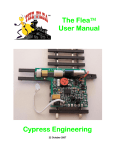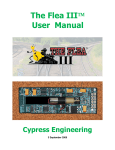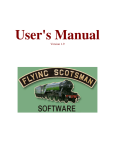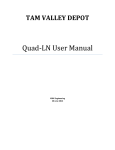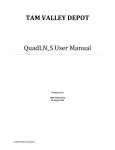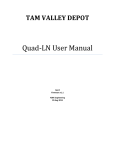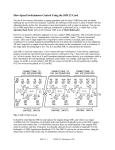Download Prodigy Info- Turnout - Model Rectifier Corporation
Transcript
Turnout Routes A turnout, commonly referred to as a “switch track” or switch, is a specialized piece of track work that moves a train to another track. Turnout Nomenclature 1. Points 1 2. Main or Tangent Route Direction of travel 2 3. Frog 4. Diverging Route - this diagram shows an example 3 of a right-hand turnout 1 4 Turnout points are hinged rails that move back and forth (left or right) and guide the train’s wheels through the turnout’s frog to either the straight leg of the turnout (Main or Tangent Route) or through the curved leg of the turnout (Diverging Route). If the curved leg goes to the right, it is known as a right-hand turnout. If it curves to the left, it is a left-hand turnout. When programming accessory decoders for turnouts, it is easier to remember the point direction (Tangent or Diverging) by wiring the turnout motors (switch machines) so that they all activate one way by your Cab (see section on “Accessory Decoders” in the User’s Manual). When programming a Route, the LCD will prompt you to enter “1or2”. Pressing 1 turns the accessory output “ON.” This operates the points so they always throw to the Main or Tangent Route of the turnout. Pressing 2 turns the accessory output “OFF.” This operates the points so they always throw to the Diverging Route of the turnout, either to the left or to the right of the Tangent Route. This way whenever you access an accessory decoder for a turnout, you know that activating 1 will make the train go straight through the turnout; and by pressing 2, the train goes though the Diverging Route of the turnout, by turning either to the right or to the left. If you wish to have the turnout points move in opposite direction of its normal programming, press DIRECTION and then ENTER to reverse the polarity. The accessory decoder on this turnout will respond accordingly when you operate the Route. If you want to independently control one turnout in the Route, you can do so by recalling the address of the turnout, It will respond normally as if it was not in the Route. © 2004 Model Rectifier Corporation Example of a Route You want your train to go east from Point “A” to Point “E”. The Route will take it through turnout numbers 1 through 4. Train direction (east) • Turnout #1 is a right hand turnout and the train will take the Diverging Route (curved leg). • Turnout #2 is a right hand turnout and the train will take the Diverging Route. B A #1 • Turnout #3 is a left hand turnout and the train will take the Main/Tangent Route (straight leg). • Turnout #4 is a left hand turnout and the train will take the Diverging Route. #2 C #3 D #4 F E In this example, all turnouts in this Route are wired normally so that activating button #1 (when prompted to enter “1or2” during operation of a Route) makes points go through the the Main/Tangent Route, and activating button #2 makes points go through the Diverging Route. The normal polarity of these turnouts is the forward () direction. To program this Route (lets call it Route #6): On your Cab – 1. Press SYS followed by 5 2. “Route SET” appears on LCD. Press ENTER. 3. Enter the Route number (1 - 31), in this case 6. Press Enter. 4. “Add Accy #” will display. Using 0 to 9, enter an accessory address number (1-255), in this case 1 for turnout #1. Press Enter. 5. “Add Accy #” shows in display again prompting you to add the next accessory into this Route. In this case, press 2 (for turnout #2). Press Enter. 6. “Add Accy #” will display. Enter 3 (for turnout #3). 7. You want the train to take the Main/Tangent Route at junction #3, which is opposite of all other junctions, you want this turnout programmed for reverse polarity. Press DIRECTION until display shows reverse (). Press ENTER. 7. “Add Accy #” will display. Enter 4 (for turnout #4). Press ENTER. 8. “Add Accy #” will display. Press ENTER without entering any data. Normal screen appears on the LCD. Congratulations…you’ve just programmed in Route #6! Operating the Route 1. Press ROUTE. 2. Using 0 to 9, enter the Route number you wish to run (in this case 6 from Route #6 from above example). Press ENTER. 3. “1or2” will display. Using the above example of Route #6 that you have set up, • Pressing 1 will make the train go from Point “A” to Point “B”. • Pressing 2 will make the points of turnouts #1, #2, and #4 to move to the Diverging Route of the turnout, while the points of turnout #3 will move (or remain) through the Main/Tangent Route (straight leg) of the turnout, causing the train to travel from Point “A” to Point “E”. 4. If you want to pick another Route for another train, repeat the steps above. 9. If not, press ENTER to escape and resume normal LCD display screen. © 2004 Model Rectifier Corporation


